Details
The use of UV transilluminators for the detection of DNA or RNA in agarose gels, is still very common, although we know quite well that the shorter the wavelenght is, the more the DNA will be damaged quickly, which is dangerous especially if the separated DNA should be used in downstream experiments like cloning or sequencing. Just seconds of UV light are enough to reduce the cloning efficiency significantly.
In contrast to UV instruments, the new innovative LED technology is using a much higher wavelenght, means energy less light. This will lead to the fact that the nucleic acids are not damaged but sometimes sensitivity is lower as compared to UV light. Furthermore regular BLUE LED technology is working well with green dyes but couldn’t be recommended with red dyes like Ethidium Bromide, because the longer wavelenght is favorable for green dyes but not for red components.
To solve these problems, Nippon Genetics developed a brand new LED technology which is unique in the world so far. We have developed a so called BLUE/GREEN LED technology and we found out that this technology shows superior sensitivity with green and red dyes.
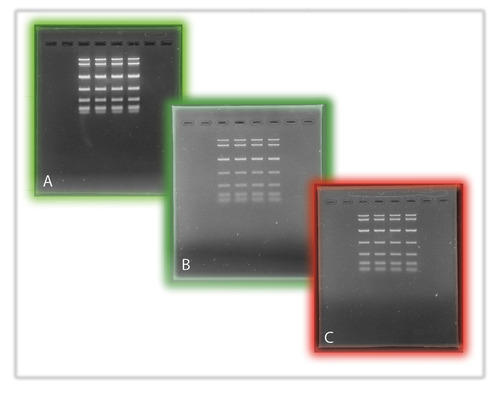
Image: The image shows the results obtained with the FastGene® Blue/Green Transilluminator. For a complete comparison with UV light, click comparison of DNA dyes.
The FastGene® Blue/Green LED Transilluminator DE comes with an attached amber filter shield, which filters the blue/green backlight efficiently. If you want to use gel documentation system you should check if your filters is working properly.
Heat protection
The FastGene® Blue/Green Transilluminator DE is equipped with a heat protection. The LEDs will shut off for 5 minutes if a specific temperature is detected. During the “cooling phase” the switch is blinking. After cooling down the LEDs will not switch on automatically and the switch is not blinking anymore. You can now switch on the transilluminator again.



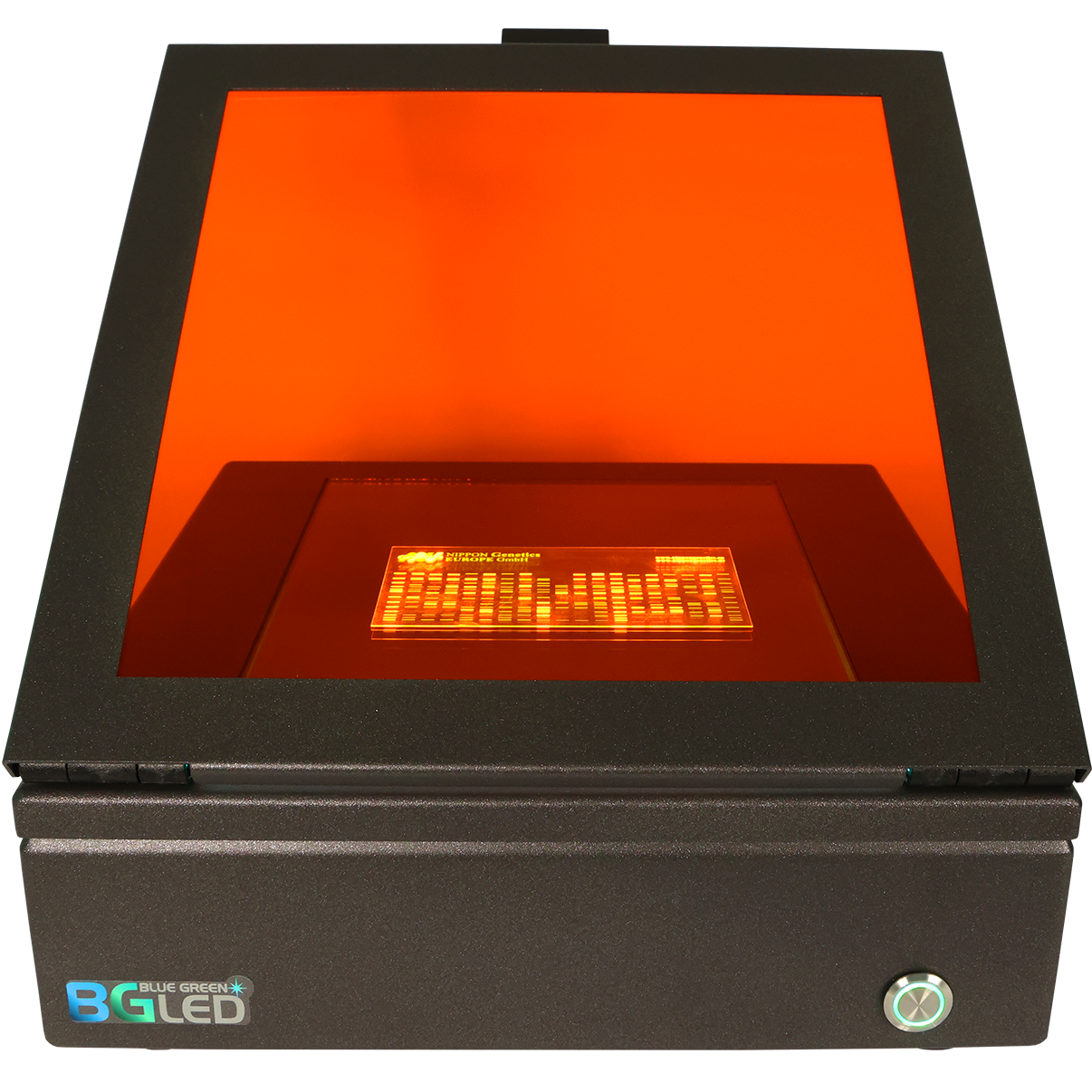
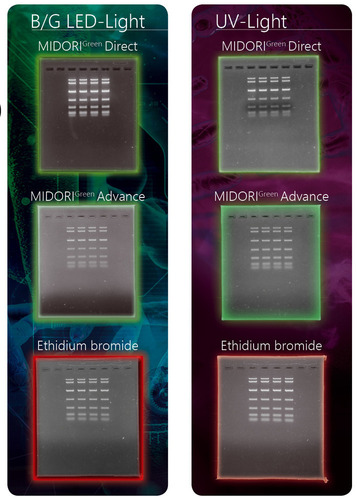
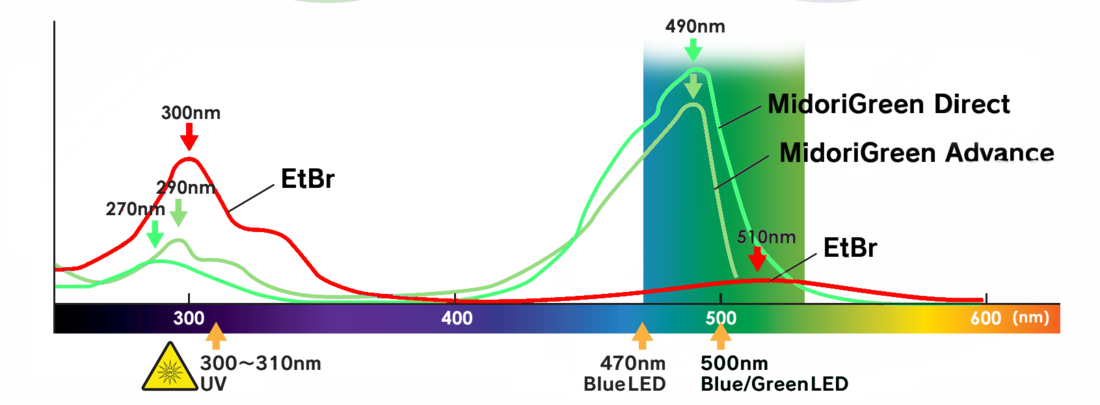
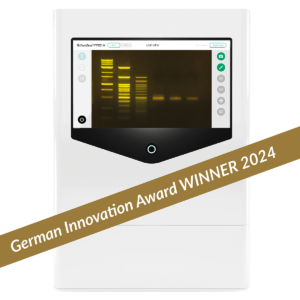
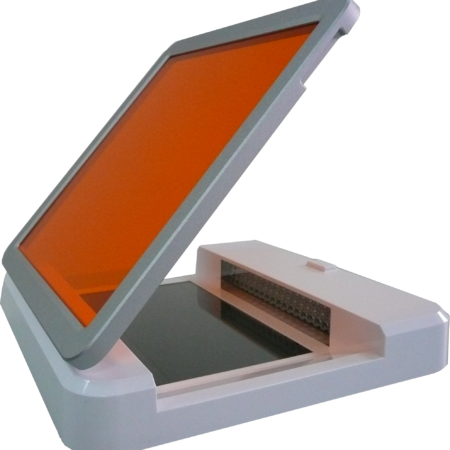
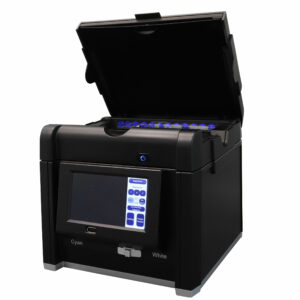

Tabea Hug, Pathologie, Universitätsmedizin Göttingen –
Schöne Performance. Banden werden klar und deutlich visualisiert, ohne diese zu zerstören.
Translation by Nippon Genetics:
Nice performance. DNA bands are visualized clearly without destroying them.
Verified User
Kevin Schmitz, Wood-Bioprocesses, Technical University of Munich –
Prior to testing the Blue/Green LED Transluminator XL, we were using a simple Blue/Green LED Flashlight (Nippon Genetics FG-11). Due to a heavier cloning work load, we were looking for an alternative with better handling comfort when it comes to large gels, that would also give stronger signals when dealing with faint PCR bands.
The Blue/Green LED Transluminator XL convinced us due to its large working surface that can easily fit large gels. Despite the size of the transilluminator surface, the indirect illumination generates an even and homogeneous signal throughout the entire surface. Additionally, we highly appreciate the adjustable built-on Amber filter plate – especially those in our lab who previously had to go through the pain of wearing additional filter glasses stacked on top of their own glasses. Its adjustability and generous size allow easy handling. Also, gel documentation using smartphone or standard laboratory cameras is really easy thanks to the adjustable filter and makes expensive documentation systems obsolete. Furthermore, the filter is very well fitted to the wavelengths used in Nippon’s Blue/Green LED technology and ascertains low background signal – especially pleasant when working with faint PCR bands! In direct comparison with the signal quality of our old UV gel documentation station, The Blue/Green LED Transilluminator drew level with the UV illuminator and was hence very convincing.
We routinely using Midori Green Advanced, Direct and Xtra and all Dyes work perfectly fine with this system.
Since we started using the Transilluminator XL for the actual gel documentation, the smaller and handy Blue/Green LED Flashlight has come into operation as an easy “on the run” check instrument to evaluate lane quality during electrophoresis. We wouldn’t want to go back to our old system again!
Verified User
Elisabeth Silberhorn, Insitut für BiochemieIII, Universität Regensburg –
Ursprünglich suchten wir nach einem Ersatz für einen Screen, mit dem man sowohl EtBr-, als auch mit anderen Ersatzstoffen gefärbte Gele analysieren kann. Sowohl der FG-08 als auch der FG-09 liefern mehr als zufriedenstellende Ergebnisse. Besonders komfortabel ist das Amber filter shield (FG-DGOF2) für die Brillenträger unter uns. Die Breite der Screens, sowie die plane Auflage der Glasplatte im Rahmen ermöglicht es uns beispielsweise den Lauf mehrerer Gele gleichzeitig zu beobachten.
Translation by Nippon Genetics:
Originally, we were looking for a replacement to analyze both EtBr and alternative DNA dyes in agarose gels. Both transilluminators the FG-08 and the FG-09 provide very satisfied results. Especially comfortable for wearer of glasses is the Amber filter shield (FG-DGOF2). The width of the screens and the big working area allows us to observe the running of several gels simultaneously.
Verified User
Martin Wist, Institut für Pharmakologie und Toxikologie, Universitätsklinikum Ulm –
We tested the Blue/Green LED Transilluminator XL to replace an older UV Transilluminator. At the beginning we thought that we might have problems to detect ethidium bromide stained DNA with the device, but the results was very satisfiying. There was nearly no difference in the intensity of the DNA bands illuminated with the UV or the Blue/Green LED Transilluminator. Therefore we are looking forward to replace our UV transilluminator with the Blue/Green LED Transilluminator XL.
Translation by Nippon Genetics:
Wir haben einen Blue/Green LED Transilluminator XL getestet um einen älteren UV Transilluminator zu ersetzen. Wir hatten im Vorfeld die Befürchtung, dass wir mit diesem Instrument Schwierigkeiten mit der Detektion von mit Ethidiumbromid gefärbter DNA haben könnten, aber die Ergebnisse waren äußerst zufriedenstellend. Es gab fast keinen Unterschied in der Intensität der DNA Banden bei der Anregung mit dem UV und dem Blue/Green LED Transilluminator XL. Dementsprechend freuen wir uns unseren UV Transilluminator durch den Blue/Green LED Transilluminator XL zu ersetzen.
Verified User
Kate Mcgraphery, Biotechnology of Natural Products, Technical University of Munich –
Before buying this device we have been using a UV transilluminator. After trying this device and seeing how it works by one of the sales representatives we were immediately intrigued. We liked the idea that it does not use UV light and can illuminate any dyes with its green blue technology. At the same time, we are able to capture pictures of the gels via a camera as well as even using your own smartphone. After using the product for the past few months we can certainly say we are happy with the product, and would not go back to UV light again!
Verified User
Hermann Kreyenberg, Klinik für Kinder- und Jugendmedizin, MRD-/Chimärismuslabor, Unversitätsklinikum Frankfurt –
We tested both devices, FastGene Blue/Green LED Transillumintor and the XL version, with preparative 1.5 mm 10% AA-Gels stained with Roti-GelStain according to our protocol evaluated for UV. Rearranged immune receptor genes were targeted by multiplexed PCR and bands were cut out for sequence analyses. Surprisingly, the visualization of all major and minor bands was perfect, definitely comparable to UV-device. After replacing EtBr the replacement of UV by Blue/Green LED will be an important step to hazard reduction at worksite laboratory!
Verified User
Dr. V. Lohmann, Institut für Molekulare Virologie, Universität Heidelberg –
We are using the device to cut out bands from preparative gels, both using Midori green and EtBr, the device is as sensitive as UV for both dyes.
Verified User